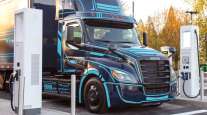Electric Trucks Will Help ‘Kill Dirty Diesel,’ California Lawmakers Say

Parked east of the California Capitol steps was a long line of vehicles as clean as they were large, including a yellow school bus, a UPS delivery truck and an AC Transit bus — all with electric or hybrid motors.
UPS ranks No. 1 on the Transport Topics Top 100 list of the largest North American for-hire carriers.
These giant machines are still so rare that they are more expensive to manufacture and buy than their diesel-burning ancestors.
California helps to offset the sticker shock with vouchers and other incentives, but those programs are so popular that the vouchers quickly get gobbled up.
RELATED: How Elon Musk and cheap oil doomed the push for natural gas vehicles
The state needs to dole out more incentives to keep the demand and the production of these vehicles flowing — and to get diesel trucks and buses off the road, argued a group of state senators who assembled Tuesday in the shade next to their environmentally friendly photo props.
Sen. Nancy Skinner, (D-Oakland), noted that those harmed the most by school-bus exhaust are the children on board.
“Children on their daily rides are exposed to these high, high levels of unhealthy — and especially damaging to vulnerable lung tissue — diesel pollution,” she said.
Enter “cap and trade,” a California climate program in which businesses essentially pay to pollute. Lawmakers in July extended the program through 2030, and the permits sold out at record prices during the last quarterly auction, generating $640 million for initiatives to reduce global-warming carbon emissions.
RELATED: Cummins debuts all-electric demonstration truck, the Aeos
Now, what to do with all of that money? Much of it is already spoken for. A bullet train from San Francisco to Los Angeles receives a share of the funding each year, as do other programs. Senate staff members estimate that roughly $1.4 billion is up for grabs for next year.
As the Legislature gears up to parcel out the cash, Skinner, Ricardo Lara, (D-Bell Gardens), Sen. Richard Pan, (D-Sacramento), and other lawmakers are calling on their colleagues to boost the subsidies that flow to incentive programs such as the California Clean Truck and Bus Program and the Hybrid and Zero-Emission Truck and Bus Project.
Diesel trucks and buses make up just 4% of all vehicle traffic, they argue, but are responsible for about a quarter of vehicular greenhouse gas emissions — and the bulk of the air pollution associated with childhood asthma and other diseases.
RELATED: Ryder signs exclusive deal with electric-truck maker Chanje
Twin Rivers, a school district northeast of Sacramento, cobbled together funding to buy eight electric school buses and plans to buy more. “This is a shining example of what we can accomplish because of our innovation,” said Pan, who is also a pediatrician.
But the clean bus and truck lobby has some stiff competition for the cap-and-trade money — and not only with popular rebates for electric cars. California fire chiefs held a news conference last week, saying the state’s disaster response network is stretched to its limits after years of drought, pest invasions and wildfires.
“For California’s firefighters, the impact of climate change isn’t a theoretical discussion: Climate disasters are a reality that we confront every day,” said Lou Paulson, president of California Professional Firefighters. “To protect Californians and the climate, our local and state response network needs more resources in place to keep small fires from becoming environmental disasters.”
Distributed by Tribune Content Agency, LLC



